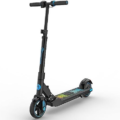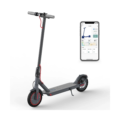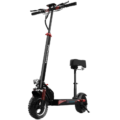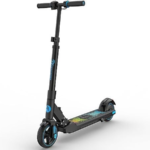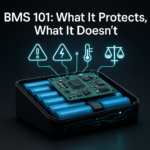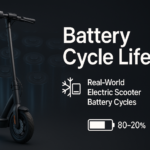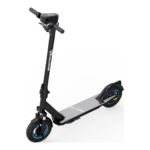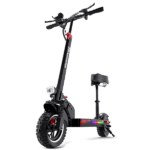- Home
- Scooters
- Electric Scooters
- EVERCROSS H7
EVERCROSS H7



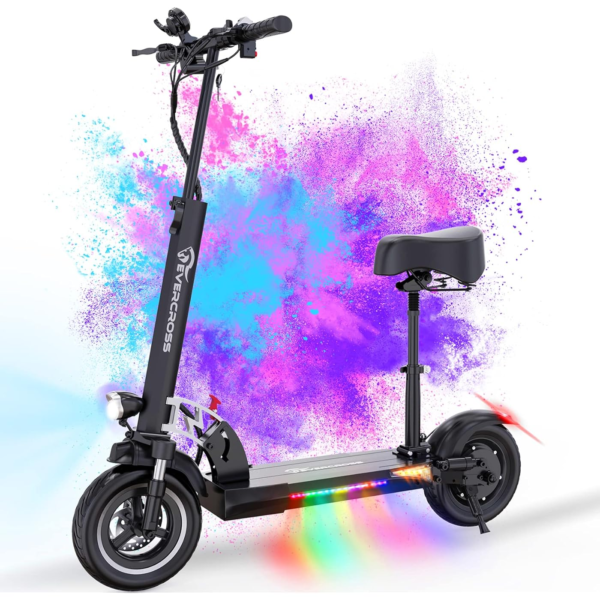
- Battery Range: 18–28 miles (30–45 km)
- Top Speed: 28 mph (45 km/h)
- Motor Power: 800 W peak (500 W rated)
- Weight Capacity: 265 lb (120 kg)
- Charging Time: ~8–9 h
- Scooter Weight: 70.9 lb (32.1 kg)
PROS
- 28 mph performance
- 48V 15Ah battery
- Front & rear disc brakes
- App connectivity (EVERCROSS PRO)
- 10″ solid off-road tires
CONS
- Heavy to lift
- IP rating not specified
- Solid tires transmit bumps


Table of contents
- What Is the EVERCROSS H7?
- How the EVERCROSS H7 Works
- Key Specifications
- Design & Build Quality
- Performance Fundamentals
- Battery, Range & Efficiency
- Ride Quality & Comfort
- Braking & Safety Features
- Portability & Daily Usability
- Maintenance & Care
- Weather & Seasonal Considerations
- EVERCROSS H7 vs Alternatives
- Who the EVERCROSS H7 Is (and Isn’t) For
- FAQs
- Glossary
- Final Thoughts
The EVERCROSS H7 is a robust, sit-or-stand electric scooter designed for riders who want more stability, comfort, and power than a basic commuter model. It blends a punchy drivetrain with a full-size deck, dual suspension, and 10-inch solid tires. If you need a dependable urban cruiser that can take rough pavement in stride—and you don’t mind a bit of weight—the H7 makes a compelling, no-nonsense choice built around official specs and a practical feature set. If you’re comparing within the brand, the lighter EVERCROSS EV08S suits easy last-mile trips, while the longer-range EVERCROSS EV10K Pro targets faster commuting.
What Is the EVERCROSS H7?
At its core, the EVERCROSS H7 is a high-torque, single-motor, 48-volt scooter with a large 15 Ah battery and a convertible seat. Because the frame is sized for adult riders and the deck is wide, it feels planted even when the surface gets patchy or the path takes a turn onto compact gravel. Meanwhile, the dual mechanical disc brakes provide familiar, predictable stopping power. You also get an app connection, speed modes, cruise control, and a bright headlight with matching LED accents for visibility.
Importantly, the H7 is not a featherweight. With a net weight around 71 lb (32.1 kg), it favors stability and comfort over one-hand carry convenience. For many riders, that trade-off is ideal: the scooter feels steady at speed, keeps its line over cracks, and shrugs off daily use without fuss. If your commute includes short lifts into a car trunk or elevator, the folding mechanism and integrated grab points help, though regular stair carries will feel strenuous.
How the EVERCROSS H7 Works
Think of the H7 like a compact electric moped you can fold. A few key parts do the heavy lifting:
- Motor: A hub motor in the rear wheel drives the scooter. It is rated at 500 W and peaks at 800 W. In practice, that means brisk launches in Sport mode and enough push to maintain urban traffic pace on level ground.
- Controller (“the brain”): The controller meters battery power to the motor based on your throttle input and chosen speed mode. Because it also monitors voltage and current, it keeps things smooth and protects the battery from abusive loads.
- Battery: A 48 V, 15 Ah lithium-ion pack (about 720 Wh) sits in the deck. The higher voltage helps the motor produce torque efficiently, while the capacity supports realistic mixed-mode rides around town without daily range anxiety.
- Throttle & Display: A handlebar throttle signals how much power you want. The LCD shows speed, battery bars, trip/odo, and riding mode. After holding a steady speed for several seconds, cruise control can maintain pace automatically.
- Brakes: Mechanical disc brakes at both wheels provide tangible bite. Additionally, releasing the throttle gently slows the scooter via a mild electronic recovery effect, which feels like engine braking in a car. When you squeeze the levers, the discs do the real stopping.
Because these pieces work together, the H7 feels calm and predictable. You press the throttle, it goes; you ease off, it coasts and trims speed; you squeeze the levers, it stops with a firm, linear pull.
Key Specifications
Below is a clean table of the manufacturer’s published specifications and closely related technical details, with both imperial and metric units shown side by side.
| Block | Item | Value |
|---|---|---|
| General | Model | EVERCROSS H7 |
| Ride Modes | Limit (10 / 15 / 25 km/h), Sport (15 / 30 / 45 km/h) | |
| App | Bluetooth app control (speed mode, cruise, ride data) | |
| Seat | Included/optional kit; removable | |
| Performance & Power | Motor Power | 500 W rated, 800 W peak |
| Top Speed (Sport) | up to 28 mph (45 km/h) | |
| Range (Claimed) | 18–28 mi (30–45 km), mode & rider dependent | |
| Drive | Rear-wheel hub motor | |
| Battery, Charging & Electrical | Battery | 48 V 15 Ah (≈ 720 Wh) |
| Charging Time | 8–9 h (typical wall charger) | |
| Display | LCD: speed, mode, trip/odo, battery, cruise indicator | |
| Extras | Cruise control after steady speed; USB charge icon support | |
| Build & Dimensions | Tires | 10-inch solid off-road tires |
| Net Weight | 70.85 lb (32.14 kg) | |
| Gross Weight | 81.44 lb (36.94 kg) | |
| Fold Mechanism | Stem fold with clamp; one-piece deck | |
| Folded Dimensions | Not officially published; shipping box is ~49.2 × 11.0 × 20.1 in (125 × 28 × 51 cm) | |
| Package Dimensions | 49.2 × 11.0 × 20.1 in (125 × 28 × 51 cm) | |
| Recommended Load | 100–265 lb (45–120 kg) | |
| Safety & Control | Brakes | Front & rear mechanical disc brakes |
| Lighting | Front headlight, tail/side LED accents | |
| Start Modes | Zero & non-zero start configurable | |
| Features & Extras | Ride Modes | Limit & Sport (see speeds above) |
| Cruise Control | Yes (engages after ~5 s steady speed) | |
| Suspension | Dual shock setup (front spring assembly; rear shock) | |
| Kickstand | Included | |
| Warranty & Compliance | Warranty | Commonly 30-day limited (seller dependent) |
| Water Resistance | Not officially rated; avoid riding in heavy rain | |
| Age Guidance | 13+ (region and seller guidance may vary) |
Notes: As always, real-world performance depends on rider mass, terrain, temperature, and tire condition. Manufacturer-published values are lab-style baselines, not guarantees.
Design & Build Quality
The H7 prioritizes solidity and comfort. The deck is broad with enough room to adjust stance or sit, and its stiff structure helps reduce flex under heavier riders. Because the battery sits low in the chassis, the center of gravity feels balanced. Consequently, the scooter tracks straight without that “twitchy” sensation some lighter commuters exhibit.
Up front, the stem locks down with a clamp and latch system. It’s sized to resist twist under hard braking, and it holds alignment well once adjusted. The cockpit is straightforward: an LCD display, a throttle, and two brake levers with short, confident travel. Switches for lights and horn are within thumb reach. Everything is easy to understand at a glance, especially for riders stepping up from entry-level models.
Fit-and-finish is practical rather than fancy. You’ll see sturdy hardware, a durable kickstand, and wide fenders that do a decent job of catching spray. The wiring is routed cleanly for a scooter in this class. There are LED strips on the deck edges for side visibility, which helps at dusk. Although the tires are solid, the tread resembles a small, blocky off-road pattern that grips well on gritty pavement and compact dirt, while remaining predictable on concrete and asphalt.
Performance Fundamentals
Acceleration Feel
In Sport mode, the EVERCROSS H7 launches with assertive but manageable torque. The initial push is smooth rather than jerky, so new riders won’t feel surprised by a sudden surge. As speed builds, the motor continues to pull with steady force until you approach the high-20s in mph. Because the controller meters power efficiently, the scooter doesn’t bog down with small inclines or headwinds; instead, it holds a cruise pace with a modest increase in throttle.
Cruising Stability
Stability is a highlight. The long deck, tall stem, and weight distribution create a planted ride that resists wobble. Even on patchy roads, the chassis keeps its line with minimal steering corrections. As a result, the scooter feels relaxed at 15–20 mph (24–32 km/h). Above that, you still get predictable behavior, though it’s wise to bend your elbows slightly and keep a light grip to absorb bumps through your arms as well as the suspension.
Hill-Climb Behavior (~7–10% grades)
On typical urban hills in the 7–10% range, the H7 climbs with composure, especially if you roll into the incline with a bit of speed. Expect a sensible pace on longer grades; the motor will favor steady torque over sprinting. If you’re heavier or carrying a backpack, select Sport mode before the hill and keep your knees flexed to help the suspension track the surface. On steeper, prolonged inclines, the scooter will slow; that’s normal for a single-motor setup focused on efficiency and ride comfort.
Battery, Range & Efficiency
The 48 V, 15 Ah pack gives you roughly 720 Wh of capacity. In practice, that capacity supports substantial mixed-mode rides:
- Claimed range: 18–28 mi (30–45 km)
- What affects range: rider weight, average speed, stop-and-go frequency, hills, temperature, and even wind.
Because the H7 is heavy and uses solid tires, it favors moderate speeds for best efficiency. Cruise around 12–18 mph (19–29 km/h) on flat ground and you’ll see very credible distances per charge. Push near top speed against a headwind and your range will drop, as it would with any scooter.
Charging Best Practices
- Charge window: 8–9 hours with the stock charger. Therefore, it’s easy to top up overnight.
- Daily use: If you ride daily, partial charges are fine. Lithium-ion batteries prefer shallow cycles rather than full discharges.
- Storage: For multi-week storage, leave the pack around 50–60% and park in a cool, dry place. Avoid leaving it in a hot trunk or a freezing garage.
- After wet roads: Dry the deck and charging port before plugging in.
These habits extend battery life, keep performance consistent, and reduce the risk of capacity fade.
Ride Quality & Comfort
Solid 10-inch tires might sound harsh, yet the H7 offsets that with suspension at both ends. Up front, a spring assembly helps absorb sharp edges and cracked seams. At the rear, a shock smooths repetitive chatter, which matters when you ride seated. Because there’s no tube to pinch, you won’t worry about flats; however, you will feel small vibrations more than you would with air-filled tires. Fortunately, the wide deck, long wheelbase, and seat option make the overall ride forgiving on typical city streets.
Ergonomics are sensible. The handlebar height works for most adults, and the grips have enough texture for control without hotspots. Stem flex is modest for the class; you may notice a touch under heavy braking or over repeated bumps, yet it remains controlled and doesn’t translate into a wobble. Together, the geometry and suspension deliver a composed ride that encourages longer trips.
Braking & Safety Features
Dual mechanical disc brakes provide strong, progressive stopping. The levers engage early and firm up after a half-pull, which gives you a reassuring bite point. Because the tires are solid, they won’t squirm under hard braking the way some soft pneumatic tires can. Still, it’s smart to load your weight slightly rearward and keep arms relaxed when you stop quickly.
When you roll off the throttle, the scooter gently slows as an energy-recovery effect engages. It’s mild—think of it as “engine braking”—so it won’t replace the discs on steep downhills, yet it helps with speed trimming in traffic.
Lighting is practical. A forward headlight increases conspicuity, the taillight shows braking, and side LEDs outline the deck in low light. Reflective stickers further enhance visibility. Although water resistance isn’t officially rated, the fenders and deck seals help shrug off light spray. Because there’s no published IP rating, ride conservatively in wet conditions and avoid deep puddles.
Portability & Daily Usability
The H7 folds quickly, but its ~71 lb (32.1 kg) net weight is the deciding factor. If your routine includes stairs, you’ll feel it. If you primarily roll to an elevator, slide it into a trunk, or park it in a garage, the weight isn’t a deal-breaker and actually contributes to calm, planted handling on the road.
Once folded, the scooter forms a tidy, easy-to-grip package. The published box size is about 49.2 × 11.0 × 20.1 in (125 × 28 × 51 cm). While actual folded dimensions aren’t officially listed, storage needs will be similar. For daily use, keep a small U-lock or folding lock handy and learn two or three fixed points near your destinations. Because the battery is integrated into the deck, charging at home is the simplest routine; however, bringing the charger to the office is also straightforward.
Maintenance & Care
You don’t need to be a mechanic to keep the H7 in great shape. A simple routine goes a long way.
Before each ride (1 minute):
- Squeeze both brake levers; feel for consistent resistance.
- Confirm the stem latch is fully seated and snug.
- Check for unusual noises or rubbing as you roll.
Every 2 weeks:
- Inspect brake pads and rotor alignment. Adjust calipers if you hear persistent scraping.
- Wipe dust from the fork and rear shock. A clean interface keeps motion smooth.
- Check fasteners on the stem clamp, folding latch, and deck. Tighten to snug—do not overtighten.
Monthly:
- Open the app, verify firmware settings (speed mode, zero/non-zero start), and reset trip logs if you track mileage.
- Inspect the charging port cover for a secure seal.
- Clean the scooter with a damp cloth; avoid spraying water directly at bearings or the deck seam.
Seasonally:
- Do a deeper bolt inspection. Replace any fastener that shows corrosion.
- Examine the tire tread. Solid tires wear slowly, but a smooth center line is a sign to plan a swap.
- Perform a full charge-and-balance cycle: charge to 100%, rest for an hour, ride, and recharge to your normal level.
This schedule keeps braking crisp, minimizes creaks, and protects the battery.
Weather & Seasonal Considerations
Rain: Without an official IP rating, treat the H7 as “splash tolerant,” not “rain-proof.” Light drizzle and damp streets are manageable if you ride gently, avoid deep puddles, and dry the scooter afterward. Keep the charging port cover seated at all times.
Heat: High temperatures reduce battery life and can soften plastics. Therefore, don’t leave the scooter in a hot car. If the deck feels hot after a vigorous ride, let it cool before charging.
Cold: Lithium-ion chemistry surrenders range in cold weather. Expect a noticeable drop below 50 °F (10 °C) and a stronger reduction near freezing. Pre-warm the battery indoors when possible, and ride in Limit mode to conserve energy.
Traction: Solid tires maintain shape across temperatures. However, cold surfaces and wet leaves cut grip. Slow down, lengthen your braking margins, and ride as if the road is always slightly slick.
EVERCROSS H7 vs Alternatives
Against light commuters: The H7 rides smoother and cruises faster. It carries heavier riders confidently and handles broken pavement better. However, it weighs far more and is not suited to frequent stair carries.
Against mid-power stand-up scooters: The H7 trades a touch of nimble feel for seated comfort and stability. If you often ride 3–6 miles at a time and prefer a calmer posture, the H7’s ergonomics may beat a lighter stand-up.
Against performance or dual-motor machines: The H7 costs less to own, draws less power, and feels approachable. Conversely, it won’t match the snap, hill speed, or braking hardware of premium dual-motor scooters. If you regularly ride steep hills or crave hard acceleration, a higher-end class will fit better.
Against off-road-focused models: The H7’s solid tires and suspension handle gravel paths and cobbles, yet they’re tuned for urban comfort, not trail pounding. For frequent dirt riding, you’d want pneumatic tires with more compliance and, ideally, hydraulic brakes.
In short, the EVERCROSS H7 excels as a stable, comfortable urban scooter for riders who value predictable handling, a convertible seat, and approachable controls.
Who the EVERCROSS H7 Is (and Isn’t) For
Great for:
- Commuters who prefer stability and a seat option.
- Students traveling across campus on rough walkways.
- Last-mile riders who prioritize comfort over ultraportability.
- Multi-modal travelers who can wheel into elevators or roll into a trunk rather than carry upstairs.
Not ideal for:
- Third-floor walk-ups with no elevator.
- Riders who need featherweight scooters for bus or subway steps.
- Those who demand extreme acceleration or long, steep hill climbs every day.
Set expectations accordingly and the H7 becomes a reliable part of your daily routine.
FAQs
1) How fast can the EVERCROSS H7 go?
In Sport mode on level ground, the H7 can reach up to 28 mph (45 km/h). Actual top speed depends on rider weight, wind, and road grade.
2) What is the real-world range?
Plan on a comfortable 10–20 miles (16–32 km) per charge with mixed speeds and some stops. Riding slower in Limit mode extends range; sustained high speeds shorten it.
3) Does it climb hills well?
Yes, for typical city grades. On 7–10% hills, it continues steadily in Sport mode, though speed will drop as the climb lengthens. For much steeper or long climbs, a more powerful class may be better.
4) Can I ride it in the rain?
Treat it as splash tolerant only. Because there’s no official IP rating, avoid heavy rain and deep puddles. Dry the scooter after wet roads and check the port cover before charging.
5) Does the EVERCROSS H7 have cruise control?
Yes. After you hold a steady speed for several seconds, cruise control engages and maintains your pace until you brake or change throttle.
6) What maintenance does it need?
Keep the brakes aligned, hardware snug, and the scooter clean. Inspect the folding latch, rotors, and wiring every couple of weeks. Charge the battery regularly and store it around 50–60% for long breaks.
7) Where can I find an “EVERCROSS H7 overview” of features in one place?
Right here. This page summarizes the model’s key traits, performance, battery details, controls, and care tips in a single reference.
Glossary
- Ah (Amp-hour): Battery capacity measurement. Higher Ah generally means more stored energy.
- Wh (Watt-hour): Battery energy (volts × amp-hours). Useful for comparing range potential.
- Controller: The scooter’s electronic “brain” that manages power flow to the motor.
- Cruise Control: A mode that holds a steady speed after you maintain the throttle for several seconds.
- Deck: The platform you stand on; it also houses the battery.
- Hub Motor: An electric motor built into the wheel hub; quiet and low-maintenance.
- KERS / Regen: Mild energy recovery when you release the throttle, which slightly slows the scooter.
- Peak Power vs Rated Power: Short bursts of higher output (peak) versus the continuous level the motor can sustain (rated).
- Stem Flex: Small fore-aft or twist movement at the handlebar stem under load; some is normal.
- IP Rating: Ingress protection against dust and water. Not officially specified for the H7.
- Limit Mode / Sport Mode: Preset speed ranges for gentler learning or maximum performance.
- Zero Start / Non-Zero Start: Whether the motor engages from a stop or only after a small kick.
- Mechanical Disc Brakes: Cable-actuated calipers squeezing rotors; predictable and serviceable.
- Solid Tires: Airless tires that cannot go flat; they transmit more road texture than pneumatics.
- Wheelbase: Distance between wheel centers; longer wheelbases ride more stable at speed.
Final Thoughts
The EVERCROSS H7 leans into comfort, stability, and straightforward controls. It accelerates with confidence, cruises smoothly over rough pavement, and stops with authority. Because the chassis is hefty and the battery is sizable, it’s happiest when you roll rather than carry. If that profile matches your daily movement—home to work, campus to apartment, or errands across town—the H7 delivers a practical, durable riding experience with features that are easy to live with.
Specifications
General
| Model The Model specifies the exact version or name of the scooter. It helps identify its unique design, features, and specifications within the manufacturer’s product line. Knowing the model makes it easier to compare options, find compatible accessories, or look up support information. | H7 |
| Brand The Brand identifies the manufacturer or company that designs and produces the scooter. A trusted brand is a sign of quality, reliability, and good customer support. Well-known brands often have higher standards for safety, performance, and after-sales service, giving you more confidence in your purchase. | EVERCROSS |
| Release Date The Release Date indicates when the scooter model was officially launched on the market. This helps you know how current the design, technology, and features are. A newer release date often means updated components, improved performance, and the latest safety or smart features. | 17 November 2025 |
| Recommended Age Recommended Age indicates the minimum age range that the scooter is designed for, based on safety, size, and ease of use. Following the recommended age helps ensure that riders can handle the scooter’s speed, weight, and controls comfortably and safely. Always check local laws and use protective gear, especially for younger riders. | +16 |
Performance & Power
| Motor Power (Wattage) What it means: The motor power, measured in watts (W), shows how strong the scooter’s electric motor is. Why it matters: Higher wattage usually means better acceleration, more torque, and improved performance on hills or rough terrain. For example, a 250W motor is good for flat city roads and light riders, while a 500W or 1000W motor provides more power for faster speeds or climbing steep inclines. | 800 W peak (500 W rated) hub motor |
| Top Speed The Top Speed indicates the maximum speed that the scooter can reach under optimal conditions. It’s usually measured on level ground with a fully charged battery and an average rider weight. A higher top speed allows you to travel longer distances faster, but always ensure you ride within legal speed limits and your personal comfort zone for safety. | 28 mph (45 km/h) |
| Battery Capacity Battery Capacity refers to the total amount of energy the scooter’s battery can store, usually measured in ampere-hours (Ah) or watt-hours (Wh). A higher battery capacity means you can ride longer distances on a single charge, reducing the need for frequent recharging. Keep in mind that actual range can vary depending on rider weight, terrain, speed, and weather conditions. | 48 V 15 Ah (720 Wh) |
| Estimated Range per Charge The Estimated Range per Charge indicates the average distance the scooter can travel on a single full battery charge. This range is calculated under optimal conditions, such as flat terrain, moderate speed, and average rider weight. Real-world range may vary depending on riding style, terrain, weather, and load. A longer range means fewer recharges and greater freedom for longer trips. | 18–28 miles (30–45 km) |
| Hill Climb Ability Hill Climb Ability describes the maximum incline or slope that the scooter can handle while maintaining stable performance. It’s typically expressed as a percentage or in degrees. A higher hill climb rating means the scooter can tackle steeper hills without losing too much speed or power. Actual climbing performance may vary based on rider weight, battery charge, and terrain conditions. | 15–20° |
| Drive System The Drive System refers to how power from the motor is delivered to the wheels. Electric scooters typically use either a hub motor (directly integrated into the wheel) or a chain/belt drive system. A high-quality drive system ensures smooth acceleration, efficient power transfer, and low maintenance. The choice of drive system affects performance, noise level, and overall ride experience. | Not specified |
Charging & Electrical
| Charging Time Charging Time indicates how long it takes to fully recharge the scooter’s battery from empty to 100% using the standard charger provided. Faster charging means less downtime and more time on the road. Actual charging time may vary slightly depending on battery capacity, charger output, and environmental conditions. | Approx. 8–9 hours |
| Battery Type Battery Type refers to the specific technology used in the scooter’s battery, which affects performance, lifespan, weight, and charging time. Most modern electric scooters use high-quality lithium-ion (Li-ion) batteries because they offer a good balance of energy density, durability, and low maintenance. A reliable battery type ensures consistent power delivery and longer riding ranges. | Lithium-ion battery |
| Removable Battery A Removable Battery means the battery pack can be easily detached from the scooter for convenient charging and replacement. This feature allows you to charge the battery separately, swap it with a spare for extended range, or securely store it indoors in extreme weather. Removable batteries add flexibility and make it easier to keep your scooter powered up wherever you are. | Non-removable internal battery (fixed pack) |
| Regenerative Braking Regenerative Braking is an energy-saving feature that converts some of the energy normally lost during braking back into battery power. When you slow down or brake, the motor works in reverse to generate electricity, which helps extend the scooter’s range and improves overall efficiency. This system also reduces wear on traditional brake components, leading to lower maintenance over time. | Yes (kinetic energy recovery on throttle release) |
| Lighting Lighting refers to the built-in front and rear lights that enhance visibility and safety when riding in low-light conditions or at night. Good lighting helps you see the road ahead and ensures that other road users can see you. Many scooters include LED headlights, taillights, and sometimes brake lights or side reflectors for added safety and compliance with local traffic regulations. | LED headlight, rear/brake light, turn signals |
Build & Dimensions
| Scooter Weight Scooter Weight refers to the total weight of the scooter when fully assembled, including the battery. This affects how easy it is to carry, lift, and store the scooter when not in use. A lighter scooter is more portable and convenient for commuting, especially if you need to carry it upstairs or onto public transport. Keep in mind that a sturdy frame and quality components may add to the weight but also contribute to better durability and ride stability. | 70.9 lb (32.1 kg) |
| Maximum Rider Weight Maximum Rider Weight indicates the highest rider weight that the scooter is designed to safely support while maintaining optimal performance and stability. Staying within this limit helps ensure reliable acceleration, braking, and climbing ability, and it protects the frame, suspension, and motor from excessive strain. Exceeding the recommended limit may reduce performance and increase wear on components. | 265 lb (120 kg) |
| Deck Size Deck Size refers to the dimensions of the scooter’s standing platform. A wider and longer deck provides more foot space, allowing you to stand comfortably and adjust your stance while riding. A well-sized deck improves balance and stability, especially on longer rides or at higher speeds. Compact decks, on the other hand, help keep the scooter lightweight and portable. | Stout frame with seat mount |
| Handlebar Height Handlebar Height refers to the distance from the deck to the handlebars, which affects your riding posture and comfort. An appropriate handlebar height helps you maintain good balance, reduces strain on your back and arms, and makes steering more comfortable. Some scooters have adjustable handlebars to fit riders of different heights, while others have a fixed height for a streamlined design. | Fixed |
| Folding Mechanism The Folding Mechanism describes how easily and securely the scooter can be folded for carrying and storage. A well-designed folding system lets you quickly collapse the scooter into a compact size, making it convenient to transport on public transit, store under a desk, or fit into a car trunk. Look for sturdy latches and safety locks to ensure the scooter stays firmly in place when folded or unfolded. | One-step folding |
| Dimensions Folded Dimensions indicate the size of the scooter when it’s fully folded. This measurement shows how much space the scooter will take up when stored or carried, making it easier to check if it will fit in your car trunk, under a desk, or in a closet. Compact folded dimensions are ideal for commuters who need to bring their scooter on public transport or store it in tight spaces. | Unfolded: 46.9 × 11.0 × 46.9 in (119.0 × 28.0 × 119.0 cm); Folded: Not specified |
| Material Material refers to the primary construction materials used for the scooter’s frame and key components. High-quality materials like aircraft-grade aluminum, reinforced steel, or durable composites provide strength, stability, and a lighter overall weight. A sturdy material ensures the scooter can handle daily wear and tear while maintaining safety and performance. | Alloy steel |
Safety & Control
| Brake Type(s) Brake Type(s) describe the braking systems the scooter uses to help you slow down or stop safely. Common brake types include mechanical brakes (like drum or disc brakes), electronic brakes, and foot brakes. Many scooters combine multiple braking systems for added safety and shorter stopping distances. The type and quality of brakes affect your control, especially when riding at higher speeds or on slopes. | Front & rear mechanical disc brakes + electronic brake |
| Suspension Suspension refers to the system that absorbs shocks and vibrations while riding, providing a smoother and more comfortable ride over uneven or rough surfaces. Scooters may have front suspension, rear suspension, or dual suspension for better shock absorption and stability. Good suspension helps reduce rider fatigue and improves control, especially when riding on bumpy roads or off-road paths. | Front & rear suspension |
| Tire Type Tire Type refers to the kind of tires the scooter uses, which directly affects ride comfort, traction, and maintenance. Common types include solid (airless) tires, pneumatic (air-filled) tires, or hybrid options. Pneumatic tires offer better shock absorption and a smoother ride on rough surfaces, while solid tires are puncture-proof and require less upkeep. The right tire type helps ensure safe handling and a comfortable ride in different conditions. | 10″ solid off-road tires |
| Tire Size Tire Size indicates the diameter and width of the scooter’s tires, which affect ride comfort, stability, and how well the scooter handles different terrains. Larger tires generally offer better shock absorption and a smoother ride over bumps and rough surfaces, while smaller tires keep the scooter lighter and more portable. Choosing the right tire size helps ensure a balance between agility and comfort. | 10-inch |
| Kickstand The Kickstand is a built-in stand that allows you to park your scooter upright when it’s not in use. A sturdy kickstand keeps the scooter stable and prevents it from tipping over, protecting it from scratches and damage. It also makes storing and accessing your scooter more convenient, whether you’re at home, work, or on the go. | Side kickstand |
| Water Resistance Rating Water Resistance Rating indicates how well the scooter is protected against water and moisture, usually shown as an IP (Ingress Protection) rating. This rating helps you understand whether the scooter can handle light rain, splashes, or wet roads without damage. While most scooters are not fully waterproof, a good water resistance rating adds peace of mind when riding in changing weather conditions. Always avoid deep puddles or submerging the scooter to protect its electrical components. | Not specified |
Features & Extras
| Display/Console The Display (or Console) shows important real-time information about your ride, helping you monitor your scooter’s status at a glance. Typical displays show speed, battery level, distance traveled, and riding mode. Some models also include additional features like Bluetooth connectivity, app integration, or backlighting for better visibility at night. A clear and easy-to-read display enhances safety and convenience on every trip. | LED/LCD dashboard with speed, battery, gear |
| Ride Modes Ride Modes refer to the different speed and power settings you can choose to match your riding style or road conditions. Common modes include eco for maximum range and energy efficiency, standard for everyday balance, and sport or turbo for higher speed and stronger acceleration. Switching between ride modes allows you to customize performance, conserve battery, and ride safely in various environments. | 3 speed modes (Limit & Sport profiles) |
| Smart App Connectivity Smart App Connectivity lets you pair your scooter with a dedicated mobile app via Bluetooth. Using the app, you can monitor real-time ride stats like speed, battery level, and range, adjust settings such as ride modes or cruise control, lock the scooter for added security, and sometimes receive firmware updates. This feature adds convenience and allows you to personalize your riding experience right from your smartphone. | EVERCROSS PRO app: lock, modes, stats |
| Anti-Theft System The Anti-Theft System helps protect your scooter from unauthorized use or theft. This feature can include built-in alarms, electronic motor locks, GPS tracking, or remote locking through a mobile app. A good anti-theft system provides peace of mind when parking your scooter in public spaces, adding an extra layer of security to safeguard your investment. | App lock |
| Cruise Control Cruise Control allows you to maintain a steady speed without continuously holding the throttle. This feature makes longer rides more comfortable by reducing hand fatigue and providing a smoother, more relaxed riding experience — especially on flat, open roads or bike lanes. For safety, cruise control can usually be easily activated or deactivated while riding. | Yes (cruise control) |
| Accessories Included Accessories Included lists the additional items that come with the scooter to enhance your riding experience and convenience. Common accessories may include a charger, kickstand, bell, lights, phone holder, or carrying strap. These extras add value by making your scooter safer, easier to use, and ready to ride straight out of the box. | Scooter, seat, charger, tools, manual |
Warranty & Compliance
| Warranty Period The Warranty Period indicates how long the manufacturer guarantees the scooter against defects in materials and workmanship under normal use. A good warranty provides peace of mind, showing the brand’s confidence in its product quality. Always check what parts are covered, such as the frame, battery, and motor, and follow the maintenance guidelines to keep your warranty valid. | 12 months (region-dependent) |
| Certifications Certifications confirm that the scooter meets specific safety, quality, and environmental standards set by recognized organizations or regulatory bodies. Common certifications may include CE, RoHS, UL, or other local compliance marks, depending on your region. These certifications ensure that the scooter is manufactured to high standards and is safe and legal to use in your country. | Local micromobility compliance |
Price Comparison




